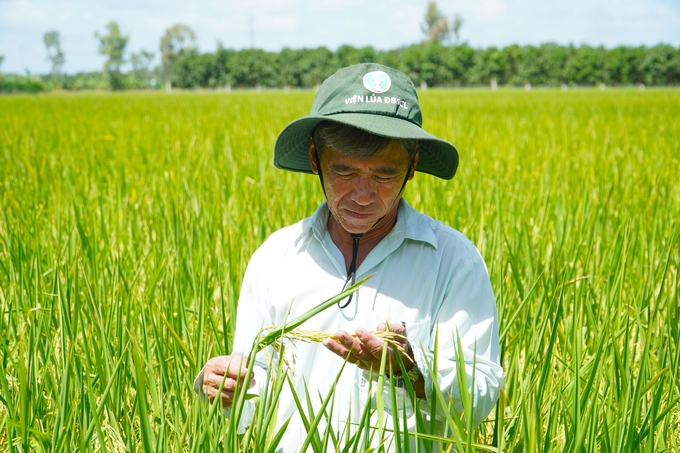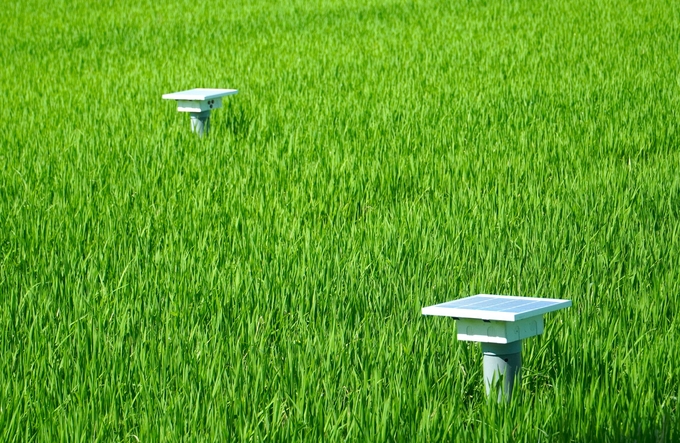November 27, 2025 | 19:57 GMT +7
November 27, 2025 | 19:57 GMT +7
Hotline: 0913.378.918
November 27, 2025 | 19:57 GMT +7
Hotline: 0913.378.918

Members of the Hung Loi Agricultural Cooperative actively visit the fields, eagerly awaiting the results of the 1 million hectares of high - quality rice project. Photo: Kim Anh.
These days, 46 members of the Hung Loi Agricultural Cooperative in Long Duc Commune, Long Phu District, Soc Trang Province, participating in the emission reduction cultivation pilot model under the 1 million hectares of high - quality rice project, are actively tending to 50 hectares of ST25 rice.
This involves the comprehensive application of mechanization with various methods such as row seeding, border seeding, incorporating fertilizer and not incorporating fertilizer to compare effectiveness.
Previously, to ensure the project criteria, the National Agricultural Extension Center (Ministry of Agriculture and Rural Development) conducted detailed training for the cooperative members on cultivation procedures, fertilizer application methods based on specialized nutrient management principles and pest management according to the "4 right" principles.
Combined with the existing foundation of applying the “3 reductions, 3 increases” and “1 must, 5 reductions” technical packages, managing the amount of fertilizer and pesticides to reduce emissions in the model is generally not difficult for the members.
In traditional practices, each hectare, Hung Loi Agricultural Cooperative members sow 120-150 kg of rice seed. However, when following the emission reduction process outlined by the project, the seed amount is reduced to just 60 kg.
Farmer Pham Hoang Tran, a member of the cooperative, stated that by systematically combining practices such as sparse seeding, reducing seed quantity and timely fertilization when the rice plants need it, although there is no precise evaluation yet, compared with the previous crop, the amount of fertilizer has been reduced by about 30%.
Additionally, previously, prolonged waterlogging in the fields led to increased methane emissions. To achieve the emission reduction goal through water management, cooperative members were supported in installing 3 environmental sensor devices in the fields.

The sensors installed in the fields measure the water level, helping farmers easily manage and adjust as needed. Photo: Van Vu.
The water level measurements in the fields will be clearly displayed to farmers via software installed on their smartphones. Using this data, the cooperative will promptly adjust the water level to the optimal range, helping the rice roots grow deeper, strengthen the plants, reduce lodging, promote healthy growth and minimize losses during harvest.
Mr. Truong Van Hung, Director of the Hung Loi Agricultural Cooperative, further noted that although there are no precise results yet regarding yield and profit, the emission levels of the model have been significantly reduced based on observations.
Additionally, the cooperative benefits from having comprehensive mechanization for rice cultivation, from land preparation to post - harvest. As a result, production and business activities under the pilot model of the 1 million hectares high - quality rice project have been more manageable.
Mr. Hung plans that after harvest, the straw left in the fields will be utilized by cooperative members for various purposes, such as: composting to create organic fertilizer to reuse for rice; feeding cattle or buffalo or growing mushrooms.
This means that the straw in the fields will be maximally utilized, rather than being traditionally burned, which would increase emissions into the environment.
According to the plan, Soc Trang Province will implement the 1 million hectares of high - quality rice project across 9 districts, towns, and cities, including: My Xuyen, Thanh Tri, My Tu, Ke Sach, Long Phu, Chau Thanh, Tran De, Nga Nam Town and Soc Trang City.

According to the technical process for producing high-quality, low-emission rice in the Mekong Delta region the Crop Production Department (Ministry of Agriculture and Rural Development), farmers must use certified seeds and sow no more than 70 kg/ha. Photo: Kim Anh.
The goal is to reach 38.500 hectares of high - quality rice cultivation by 2025, with 78 cooperatives and farmer organizations participating. By 2030, the area involved in the project is expected to reach 72.000 hectares, with over 100 cooperatives and farmer organizations involved.
The main solutions proposed by the Soc Trang Department of Agriculture and Rural Development include reviewing, applying and perfecting technical packages to ensure sustainable development criteria. Additionally, plan to reorganize production; enhance training and capacity-building; apply scientific and technological advancements, digital transformation, mechanization; focus on trade promotion and linking production with rice consumption.
Translated by Phuong Linh

(VAN) On November 27, in the meeting with Minister Tran Duc Thang, Mayor Yin Yong shared Beijing’s experience to improve environment and air quality.

(VAN) After 30 years, both sides identified strategic areas of cooperation: sustainable production, increasing coffee value and training for farmers.
/2025/11/27/4910-4-164708_294.jpg)
(VAN) On the afternoon of November 27 in Beijing, Minister of Agriculture and Environment Tran Duc Thang held a working session with several major Chinese enterprises operating in the agriculture and environment sector.

(VAN) The Department of Animal Health issued a provisional guideline requesting local authorities to increase surveillance, collect samples for testing, and conduct epidemiological investigations according to the established procedure.

(VAN) The United Nations recommends that Vietnam utilize data and artificial intelligence to enhance early disaster warnings and reduce GDP losses by 3.2% in the context of climate change.

(VAN) On the morning of November 27 in Beijing, Minister Tran Duc Thang and the Deputy Commissioner General of the General Administration of Customs of China signed a protocol on fresh jackfruit exports.

(VAN) As floodwaters recede, a vast network of irrigation works across eastern Gia Lai is emerging in a state of severe disrepair, with extensive damage demanding urgent restoration ahead of the 2025-2026 winter-spring cropping season.